How Olympus Designed the PEN-F for ‘Timelessness’
![]()
I’ve always found Olympus cameras to have excellent quality. But when I first picked up the PEN-F, it was immediately apparent that the quality of this camera is of a higher caliber. The PEN-F oozes quality.
The allure of small cameras have always revolved around the possibility of having a high quality, precision photographic tool that doesn’t get in the way and thus, ready to go anywhere with you. There have been many small cameras over the years, especially point-and-shoots that were the mainstay for the general consumer for decades. Of course, these cameras fell by the wayside with the arrival of the smartphone. But the essence of small cameras, or compactness — of something that is well made and efficiently packaged — continues to entice photographers around the world. Like luxury watches and jewelry, small products have a magnetic quality that many people around the world feel drawn to.
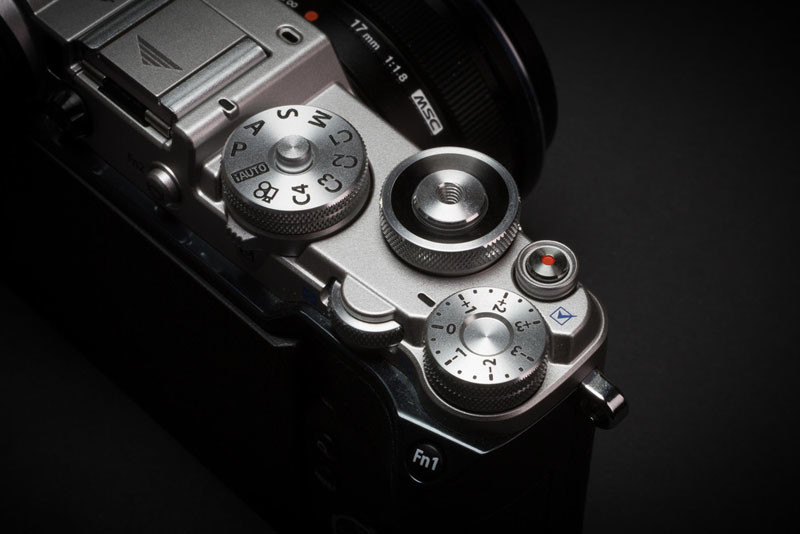
The Olympus PEN-F is a thoroughly modern camera. On a camera that fits in the palm of you hand, you’ve got a camera with IBIS, high-resolution multi-shot capabilities, an extensive choice of excellent lenses, 20 megapixels of resolution, an unprecedented level of in-camera color controls and more. With the new PEN-F, I get sort of a guilty pleasure when using it — it’s as if you’re getting away with something you shouldn’t.
Small products are interesting from an industrial design point of view. Details, such as the intricate knurling on the dials increase in prominence. The fit and finish is likewise up for closer scrutiny. Imagine the reverse. A larger product with a small details will be relatively less noticeable. This implies that the amount of attention you have to give to tiny details increase greatly. The user too will notice those tiny details. Another aspect of small products, and this is obvious, is that there is less real estate for the various buttons and dials you might want to place on the product. You need to be able to hold small products securely too. There are a multitude of problems to solve while thinking not only about the end user but also functionality, manufacturability, usability while keeping costs down. It’s akin to solving a 10,000-piece puzzle with an abstract pattern — under a deadline.

When researching for this article, I came across the fact that Olympus has made well over 300 cameras since 1936. While I don’t have figures from other manufacturers, that’s a lot of cameras. Especially when you consider that each and every camera was thought through and through, sweated over and obsessively developed at great expense — over and over again. For me, this simple metric puts Olympus’ heritage in perspective. They’ve been manufacturing cameras for 80 years this year (optics for even longer) and hundreds of millions of people have owned an Olympus.

While Olympus’ pre-war cameras were based on TLR (twin-lens reflex) and folding cameras as was in fashion at the time, it was their post-war cameras such as the PEN, OM and XA series that established Olympus as a global player. These cameras were envisioned the legendary camera designer Yoshihisa Maitani. His philosophy on camera design and development helped Olympus cameras become a serious contender for photographers everywhere.
Mr. Maitani, who needs no introduction and is a huge influence on Olympus camera development and design, was an innovator with a singular vision. His primary motivation was as simple as it was refreshing — he just wanted to take pictures. If a picture couldn’t be taken for a technical reason (such as a macro shot) or if a camera was too expensive to own (a real problem post-war), he’d wonder why such a camera didn’t exist and would invent one that satisfied his criteria. Maitani noted that getting an innovative new camera manufactured required him to break through two barriers — the technological barrier and the barrier of accepted wisdom.
Nowadays, one might say ‘think outside the box’ and Maitani did just that back in the fifties and sixties. Technological barriers are just that — invent the technologies required to realise the new camera and overcome manufacturing problems — including cost — associated with it. As for breaking through the second barrier, he would have to find ways around recalcitrant factory bosses who refused to manufacture his cameras, as well as a skeptical sales department that didn’t believe his cameras will sell. Maitani’s cameras were eventually made after breaking through both barriers and sold in large quantities around the world. Maitani’s masterpieces, the PEN and OM series, lives on today in Olympus’ modern digital camera line-up. As for the XA, I for one would love to see it revived in digital form.
80th Anniversary
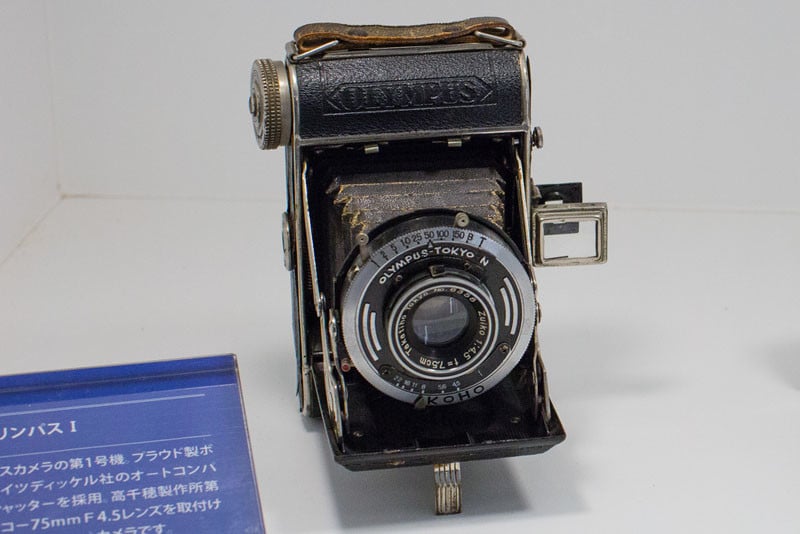
This year marks Olympus’ 80th anniversary since the company’s first camera, the 1936 Semi-Olympus I. And to mark this anniversary, they introduced the PEN-F, a new addition to the venerable PEN series. I found this camera — and the timing of its release — interesting so I contacted Olympus to learn more about the product development and industrial design of the PEN-F. I spoke with Eiji Shirota (product development) and Takeshi Nohara (industrial design) and this is the design story for the Olympus PEN-F, possibly the most beautiful camera out on the market today.
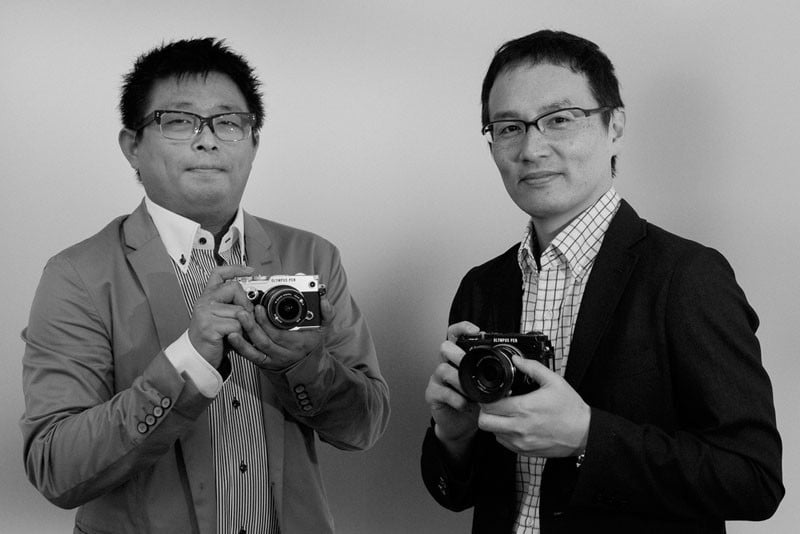
If I were to sum up my impression of Eiji and Takeshi in one word, it would be ‘professionalism’. For Eiji, his objective in his job as a product planning manager is to create cameras that don’t exist. He is very knowledgeable about the photographic equipment industry and how photography is being pursued around the world. His drive to create something new is tempered only by the reality of time and budget constraints. Takeshi, on the other hand, is an industrial designer with a wide range of experience. He loves products — he mentions watches, speakers, and eyewear — that have a sense of playfulness about them. He always tries to find ways to introduce a little bit of whimsy into the cameras he designs, as we will see shortly.
Product Development of the PEN-F
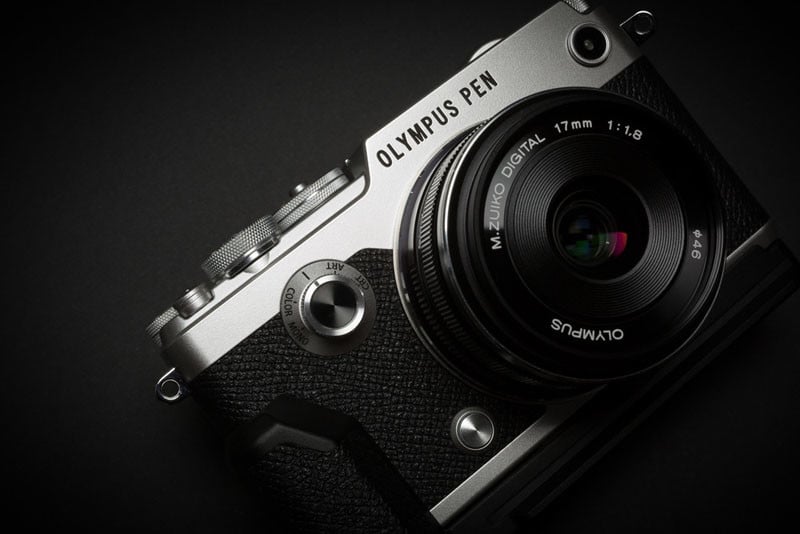
Olympus took a new look at the current PEN line-up and wanted to find new value to offer. Eiji told me that they initially identified three ideas they wanted to incorporate into the new camera — a rangefinder style body (the first EVF equipped PEN), a camera that evokes Olympus’ heritage, and the ability for the photographer to tailor their photographs to taste in-camera.
The first item, I felt, was a given. But I found the second and third item of interest so I asked him to expand on them. Eiji said that he felt that there are certain aspects that proffer a strong camera-like feel. That there are cameras that linger in the mind — cameras that give photography a physical embodiment. One of the goals for the PEN-F was to instill that embodiment — to connect with the essence of the camera as a photographic tool that we all know and remember. So when they started to talk about what they wanted to make, they opted to create what they felt was this ‘camera essence’. This included the rangefinder form factor (point one) and to connect with the original PEN F from 1963 (from a heritage point of view, point two).
Eiji said he feels that what people expect most from cameras is excellent image quality. So they looked at the whole image making process. They thought about how a beautiful design would prompt people to pick up the camera. How excellent functionality (in the human interface design) would promote getting to know the camera well and get them to go out to shoot. And how having the ability to easily fine-tune pictures to the photographer’s taste in-camera would be desirable. The product development team paid close attention to each of these user experience steps.
Cameras in the past offered simple controls — shutter speed, aperture and a choice of film. With digital imaging, we’re offered an expanded array of picture taking controls. Eiji points out that in digital photography, you can do the same on ubiquitous smartphones but the difference with dedicated cameras is that instead of having the smartphone software make decisions for you; on a dedicated camera the photographer is in control. Taking this notion to another level, Eiji wanted to introduce what will become the most advanced in-camera picture style control that you could manipulate while shooting.
Encapsulated in the front Creative dial, several creative shooting functions are available, such as the new Monochrome and Color Profile Control. This innovative idea became a reality by combining quick and easy access to color parameters. Eiji said that they have included some presets to demonstrate what they’re capable of to get things going for the user. He also said that they’re considering ways to add new presets through firmware updates. The idea is to give the photographer the ability to widen their picture making possibilities. This, in turn he feels, widens photographic horizons.
![]()
This picture making concept (my term, not Eiji’s) using the PEN-F’s deep in-camera color editing capability delves into crafting JPEGs that are on target to what the photographer visualises. More and more professionals are embracing JPEGs, suggesting that they’re starting to trust the color science of modern sensors and processors, as well as growing tired of endless editing in photo editing software. Of course, this doesn’t mean that Eiji believes RAW is going away but shooting JPEG is a trend that is gaining traction. As Jun Takahashi, Olympus’ general manager of the design center says, it’s all about expressing a feeling when taking a picture — were you happy, sad, moody, crabby? How did you feel about the subject? What kind of picture expresses your feeling? For Eiji, everything he can do to expand people’s photographic horizons is a good thing. It’s this kind of thinking that went into this picture making concept.
I pointed out that the in-camera color edits are primary useful for JPEG shooters. True, says Eiji but you can apply your presets using Olympus’ photo editing software to RAWs if you want to. Personally, I was happy to shoot JPEGs with the PEN-F — the pictures came out beautiful but you had to get used to how the color on the camera’s LCD and your desktop monitor correspond. It didn’t take me long to get a feel for it. Of course, if the camera’s LCD was calibrated, it might be better but then again, with different color gamuts between camera and monitor, I don’t think it’ll make a huge difference.
Eiji’s picture-making concept goes for hardware as well. There are benefits in a camera based on a Micro Four Thirds sensor — the compactness of the system (including small lenses) that allows photographers to go to places they normally wouldn’t with a larger camera kit. The small form factor benefits daily usage by basically disappearing when carry it around all day. And with 20 megapixels on the new sensor, there’s more than enough resolution for the majority of needs.
Eiji puts it in perspective when he said that with smartphones, you could take pictures easily and share them online quickly. But this is after the act of taking the picture because the smartphone makes all of the picture taking decisions for you. The user, essentially, shares what the smartphone took. The PEN-F concentrates on the act of taking a picture. Viewing a scene through a viewfinder and making composition, exposure and color decisions while taking the pictures, he feels, is much more enjoyable.
I was glad to hear Eiji talking a lot about ‘enjoyment’ and ‘fun’. After all, photography as a hobby should be those things. Using the PEN-F is indeed fun. While it helps to have the updated sensor, I think Eiji nailed it by emphasising a sense of enjoyment in photography. With Eiji’s product development groundwork set, let’s switch over to Takeshi to hear the industrial design side of the story.
The Industrial Design of the PEN-F
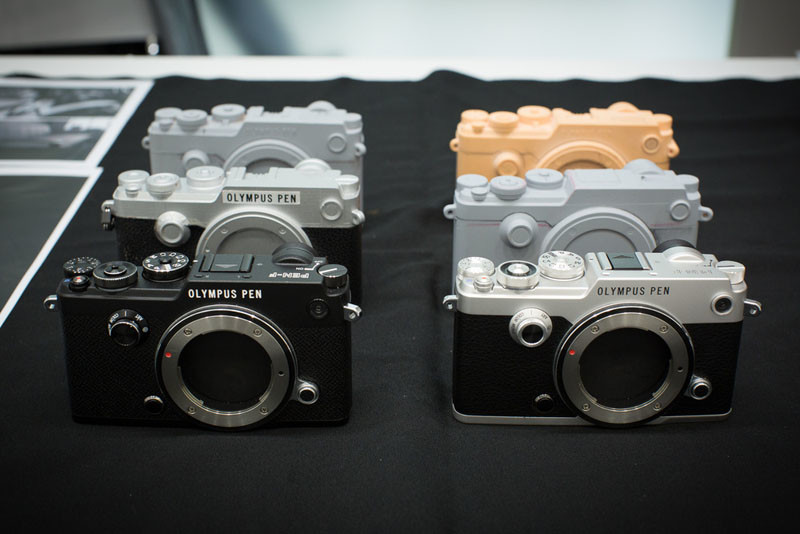
Takeshi said that when they started to work on the PEN-F, they started with a blank slate. It wasn’t as if there was a clear goal in terms of the physical look and feel for the camera. At the earliest stages of the design work, a number of Olympus designers took part in a design competition to flesh out ideas. Together, the designers explored everything from the outlandish (decidedly un-camera-like) to conservative designs.
While exploring design ideas, Takeshi and fellow designers kept Eiji’s three concepts in mind (to remind — rangefinder form factor, Olympus’ heritage and picture-making prowess). In response, Takeshi reached a decision to re-examine the more conservative aspects of the camera. There’s a handy word in Japanese — rashisa, which means typical of, appropriate for, and worthy of the name. He opted for a design that emphasised ‘camera-rashisa’, or a design that is worthy of a serious camera. The reason will be apparent in a couple of paragraphs…
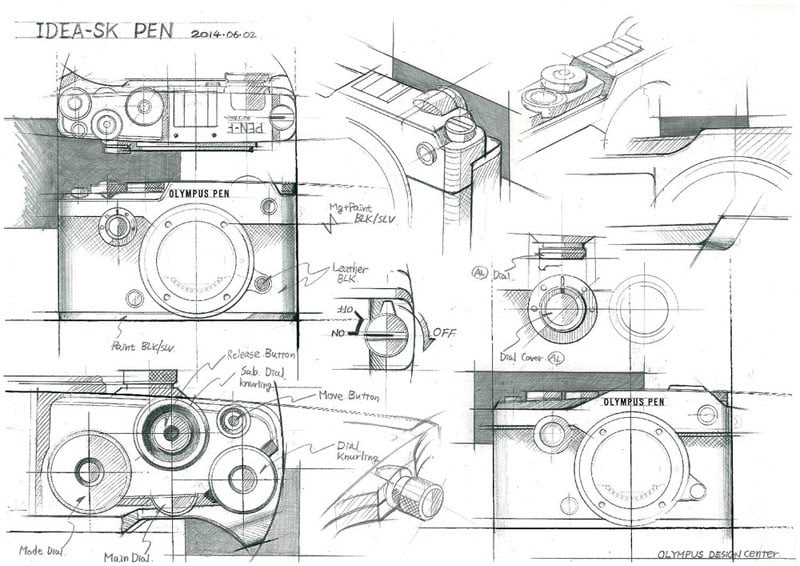
Typical for an industrial designer, Takeshi looked beyond what the competition offered and thought a lot about the potential user of the camera — someone that appreciates objects that are beautifully designed. Takeshi’s guess was that the potential user has an appreciation for well made products and is willing to spend money on quality products. He thought about what kind of bag this person uses. He thought about what their sofa looks like. What kind of watch would such a person wear? For example, Takeshi said he looked at Omega watches at one point. Not modern ones but vintage ones that they would have owned and appreciated over the years. The inspirations for the industrial design of the PEN-F was in effect, informed by products that were well made and held up well over time.
Eventually, Takeshi arrived at his industrial design concept for the PEN-F: enthusiasm, relationship and heritage. (Mind you, I’m just translating these words literally. In a Japanese language context, they sound better.) Enthusiasm implies a camera that makes you want to pick it up, get to know it well and use it. What exactly would prompt a photographer to feel this way? As the word implies, relationship explores the relationship between the photographer and the camera. Like a well-liked tool, Takeshi pondered about what goes into creating a long-lasting relationship (certainly not an outlandish design, as explored in the initial stages). Finally, heritage is the continuation of the PEN series of cameras that have been popular around the world on and off for decades.
Takeshi said that the industrial design of the PEN-F started with the position of the thumb because this determines how the camera is held. The front of the camera was left clean (grip-less) to differentiate from other cameras in the line-up, and arrive at the simplest possible form — which in turn was inspired by the design of the original PEN F. The lack of a front grip may be unusual today but Takeshi pointed out that traditionally, cameras had no grip. A grip-less design was chosen internally because people felt it looked new and that it looked more elegant. This, of course didn’t solve the fact that a grip-less camera wasn’t secure or comfortable to hold. But Takeshi had brainstormed and came up with a clever solution.
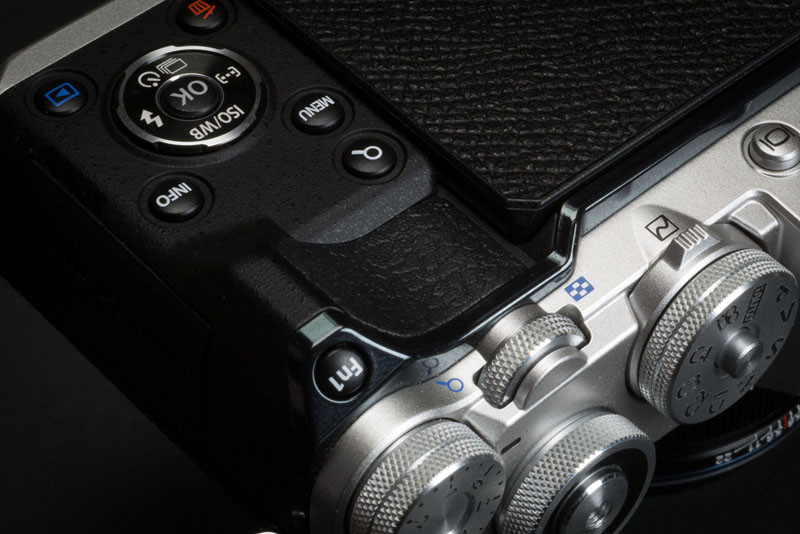
Takeshi proposed a ‘thumb grip’ concept for the PEN-F in the form of a recessed space for the thumb on the back of the camera. He made a mock-up and verified that the solution enabled a secure grip on the camera despite it not having a more common front grip. But creating a recessed space on a camera isn’t easy to do. The camera body is basically an enclosure for the electronics and structural elements inside. And the size of this enclosure is decided within very tight tolerances — you simply can’t dig into an enclosure without hitting something vital inside. Takeshi however, insisted and worked with the engineers to find a way to create the recessed thumb space. He eventually succeeded and I can attest that the camera is very secure and comfortable to hold. Just don’t expect to put a 300mm lens on it and have it feel the same way — that’s why they have the add-on grip (called the ECG-4) for users of longer focal length lenses. But as a street/lifestyle/travel camera with small primes and zooms, the rear grip feels superb.
In this way, the PEN-F is different from current camera designs in that instead of having protrusions on the front to accommodate a secure grip, Takeshi’s elegant solution provides a compact — and clean — industrial design.
The PEN-F has no visible screws, which lends it a sense of solidity and adds to the high-quality feel to it. This is achieved by placing screws under the leatherette. Normally, camera manufacturers avoid placing screws under the leatherette because this makes servicing more expensive. One would have to peel the leatherette off to access the screws for disassembly. The leatherette would then have to be discarded and replaced with a new one. It would also take more time to disassemble. But for the PEN-F, Olympus decided that quality in fit, finish and construction was more important.
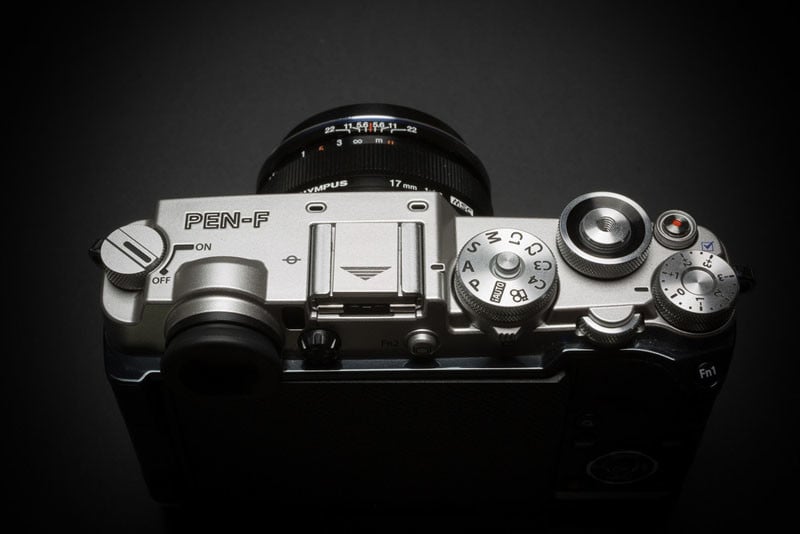
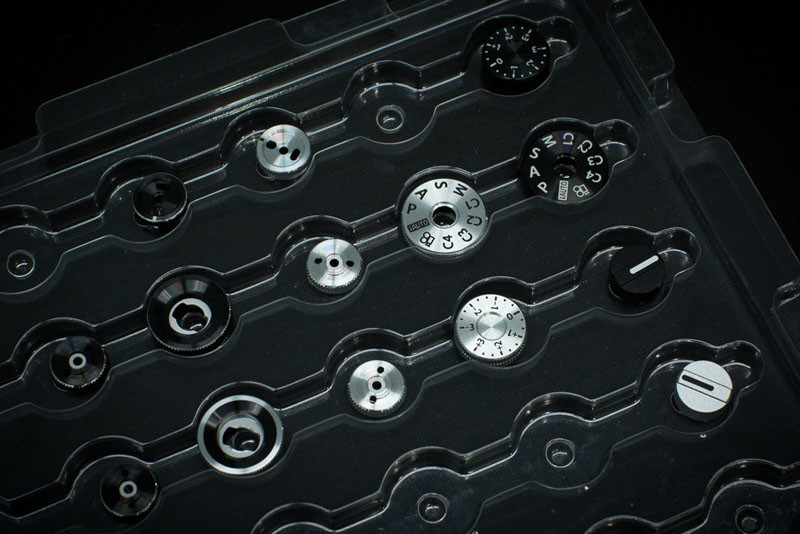
The PEN-F is a small camera. So I was surprised to see 6 dials on the camera and that those dials didn’t crowd the surface. Dial proportions and placement are well considered. Takeshi said that each dial has different torque settings depending on its size, location, function, and usage frequency. For example, the front dial that surrounds the shutter button is the most used, so the torque is looser than the exposure compensation dial, which is larger, operated by the thumb and is used more sparingly. This kind of detailed thinking contributes to a sense of purpose when operating the camera.
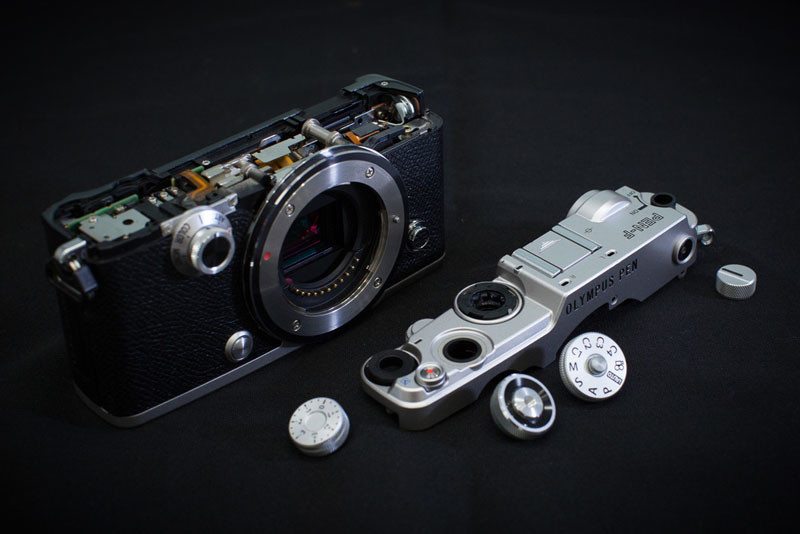
Speaking of dials, the on/off switch on the PEN-F is a dial. I asked Takeshi about this because I found it surprising and a little strange. As mentioned before, Takeshi likes to introduce a bit of playfulness in his designs and here he envisioned the wind up crank on a traditional film camera as the on/off dial. Why not, he asks. I’ve heard people complain about this dial but I didn’t have any issues about it. It’s pretty hard to accidentally turn on or off the camera because you need to use a bit of strength to engage it.
The Creative dial on the front of the camera, along with the lever below the Mode dial on the back gives access to the PEN-F’s color control functions. The dial’s position is inspired from the original PEN F. Takeshi says its primary purpose is to give people quick access to these features, which is a marquee feature on this camera. Many people I have spoken to wish this dial were a programmable dial. For me, I’m not too sure. It would be hard to use because you would be touching it with your index finger at an unnatural angle. This implies that the dial will need to have less torque to move it easily. That in turn would imply that you might accidentally change whatever you programmed it for. Considering that the PEN-F’s color control prowess is its marquee feature, I feel it belongs where it is. I found it fun to fiddle with.

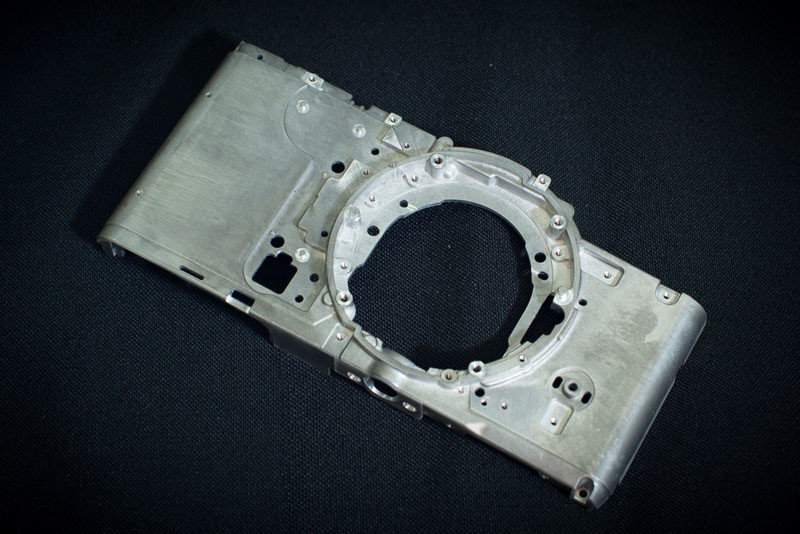
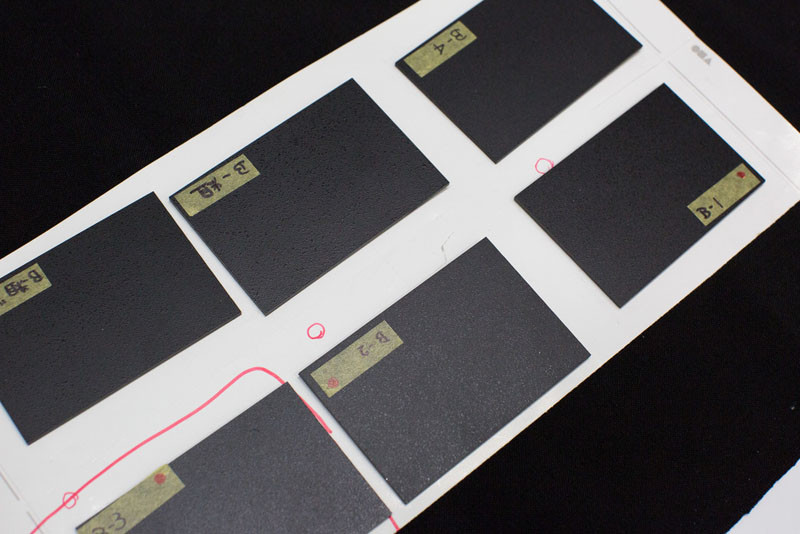
The sense of quality one gets when holding the PEN-F comes the materials, finish and attention to detail. The top plate and the front of the body is constructed from magnesium alloy and goes through an expensive, laborious process to get the finish Takeshi was looking for. On black models, the black finish is the result of hundreds of tests. The dials and some of the buttons are made from aluminium. The leatherette is precisely laser cut to fit with tight tolerances. The buttons have good resistance and as mentioned previously, the dial torque is tuned according to placement, feature, function and usage frequency. Many of the buttons and all of the dials are made from metal. The dials have an intricate knurling pattern. The PEN-F feels hefty — but not heavy. To me, the PEN-F is a beautiful camera, to look at, to hold, and to use.
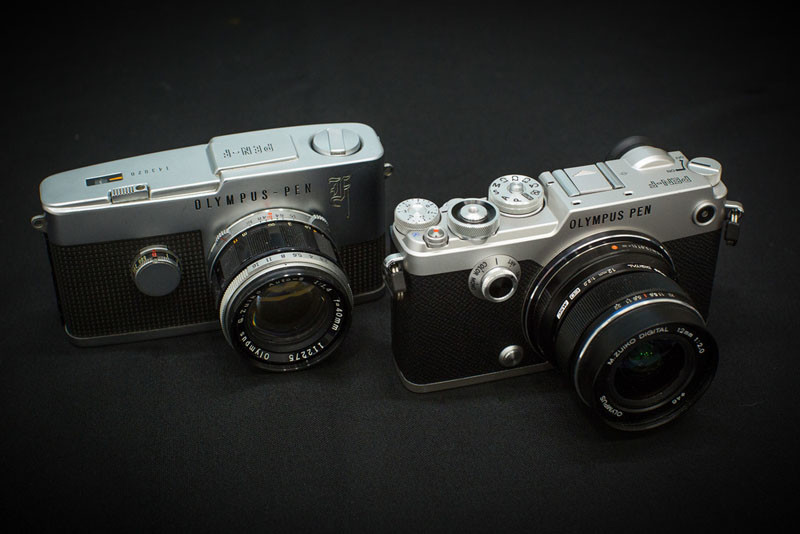
The PEN series heritage lives on and expanded with thoroughly modern picture-making features and improved usability. The styling of the PEN-F may be inspired from the original 1960’s PEN F but it is in fact a modern interpretation of what a camera is.
I asked Takeshi what one word he would use to describe the result of his efforts. His reply was ‘timelessness’. It may be asking too much for a digital camera but Takeshi hopes that the photographer will use the PEN-F for a long time and when the time comes to retire it, the photographer would want to place it on a shelf instead of getting rid of it. Perhaps even become an heirloom — but he concedes that’s probably too much to wish for. It goes to show how much passion he put into the design of the PEN-F. It would seem that Takeshi is a hopeless romantic at heart and we gain a lovely camera because of it.
A big thank you goes to Eiji and Takeshi as well as everyone at Olympus who have graciously helped me write this article.
About the author: Aage Granaas is a photographer, industrial designer, and entrepreneur. He writes about photography, camera development, and industrial design on his journal, Senzo, which can be subscribed to as a newsletter. This article was originally published here.